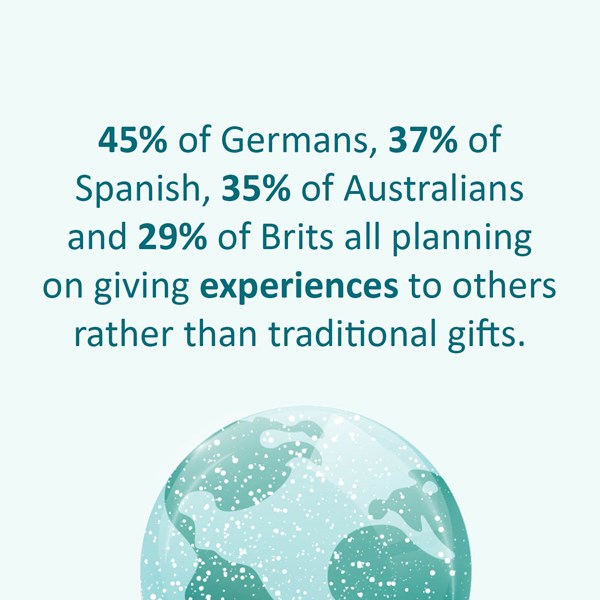Key marketing trends for Christmas 2022 and beyond

- 23 December 2022
The build up to Christmas is always fit to bursting with marketing campaigns and many brands around the world will be working to get their messages heard. In this article, we'll explore the growing trends that we are seeing this Christmas and which are set to carry on into 2023.
Christmas can be a tricky time for many marketers, with many businesses looking to the holiday season to boost sales or close out a successful financial year. So what are some of the key trends marketers need consider for 2022 going into 2023?
Keeping it local
Lockdown taught many people the virtues of shopping locally. Research from Groupon Merchants concluded that people haven’t forgotten the local suppliers that supported them through hard times and are keen to return the favour, with 41% of people looking to shun large corporates in favour of local businesses.
This figure rises if sustainability and issues like greenwashing are considered by consumers with local businesses being regarded as a more ethical choice.
Sustainability concerns amongst households
How a product is packaged is again a key issue for marketers and brands alike. Our own research found that the vast majority (82%) of UK adults agree companies use too much packaging when delivering or selling in-store products. Additionally, 78% want to see more being done by large companies to promote sustainable packaging.
The issue of over-packaging also influenced consumers’ shopping habits, with 30% stating that receiving an online order with excess packaging has put them off ordering from the same company again. When looking at specific companies, nearly half (48%) of respondents label Amazon as the worst offender for excess packaging, a slight decrease from 52% in 2020.
So what have brands like Amazon done to adapt? In an effort to meet the sustainable demands of its consumers, one of the most noticeable changes is that Amazon like many e-tailers has switched from single use delivery bags to recyclable paper delivery bags and cardboard envelopes. Additionally, the brand has begun offering incentives to vendors who convert their packaging to Frustration Free Packaging (FFP), to encourage more vendors to adopt these best-in-class standards.
There are now more than 2 million products that qualify under Amazon's FFP programs.
Consumers are buying to a budget
Soaring energy prices across mainland Europe and a cost-of-living crisis in the UK will likely see 36% of British shoppers spend less on themselves this Christmas and 27% spend less on others. A trend mirrored in the United States, which will see 29% of shoppers spend less on themselves, and 17% less on others.
Around one-quarter of shoppers in France, Germany and Italy will also cut their spending on both themselves and others. On the flip side, economies which are rising such as the UAE are seeing the opposite, with 22% of shoppers planning on spending more on themselves, and 18% more on others.
Whatever market you target, an understanding of the particular needs of your customers and their economic situation is critical for developing long-term customers.
Experiences over traditional gifts
What people buy is also slowly changing. Experience vouchers are on trend this year. These types of gifts are rising in popularity throughout the world with 45% of Germans, 37% of Spanish, 35% of Australians and 29% of Brits all planning on giving experiences to others rather than traditional gifts.

Overlooking key demographics
Ensuring all demographics are catered for is also key at this time of year. Entertainment news website Huffpost looked into this and found that: “the beauty and entertainment industries have been quietly quitting on older women for decades. These older women are ‘Queenagers’, they have large spending power but are often hugely overlooked by brands.”
This untapped group of educated, affluent and open-minded women out-spends millennials by 250%. Queenagers are also behind 90% of all household spending decisions, earning them the title of ‘super consumers' by Forbes.
It's clear that there is a huge opportunity for brands to speak to this switched-on consumer base. Inclusion could be as simple as using more representative images and adjusting the audience parameters on Facebook ads.
Ecommerce still leads the way
This year all the indicators point to online shopping leading the high street again with Adobe predicting a 2.5% growth in online sales from November to December. With online sales starting earlier than ever high-street brands are having to work harder than ever to create innovative shopping experiences to drive spending.
Even in-person purchases often start with research online, meaning that the customer experience starts when they first search for your brand online and continue until the purchase is complete, fail one step and you might let in a more agile competitor.
Whatever the experience, with over half of customers now posting online reviews after a retail experience, every interaction with your brand is now magnified and shared with the masses online.
A very global Christmas and New Year
Global trends are hitting each county in one form or another this Christmas and forcing brands to evolve to meet the expectations of their customers. Making a clear and important mark this year, sustainability and inclusivity are set to grow further into 2023.
Take a look at the CIM Impact of Marketing Report Two: Rebuilding for Globalisation for more insights into how marketers need to adapt for global campaigns.
Sync up your internal organisational strategy and ensure everyone is speaking from the same objectives and culture with our Internal Communications course.

- 0 views

 FAQs
FAQs
 Log in
Log in
 MyCIM
MyCIM






